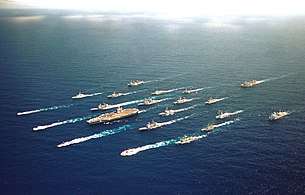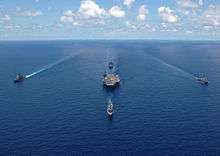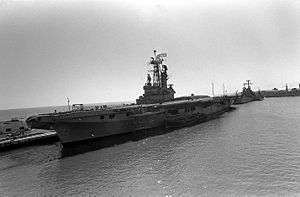Carrier battle group

A carrier battle group (CVBG) consists of an aircraft carrier (designated CV) and its large number of escorts, together defining the group. The first naval task forces built around carriers appeared just prior to and during World War II. The Imperial Japanese Navy, IJN, was the first to assemble a large number of carriers into a single task force, known as Kido Butai. This task force was used with devastating effect in the Imperial Japanese Navy's Attack on Pearl Harbor. Kido Butai operated as the IJN's main carrier battle group until four of its carriers were sunk at the Battle of Midway. In contrast, the United States Navy deployed its large carriers in separate formations, with each carrier assigned its own cruiser and destroyer escorts. These single-carrier formations would often be paired or grouped together for certain assignments, most notably the Battle of the Coral Sea and Midway. By 1943, however, large numbers of fleet and light carriers became available, which required larger formations of three or four carriers. These groups eventually formed the Fast Carrier Task Force, which became the primary battle unit of the U.S. Fifth and Third Fleets.
With the construction of the large 'super carriers' of the Cold War era, the practice of operating each carrier in a single formation was revived. During the Cold War, the main role of the CVBG in case of conflict with the Soviet Union would have been to protect Atlantic supply routes between the United States and Europe, while the role of the Soviet Navy would have been to interrupt these sea lanes, a fundamentally easier task. Because the Soviet Union had no large carriers of its own, a situation of dueling aircraft carriers would have been unlikely. However, a primary mission of the Soviet Navy's attack submarines was to track every allied battle group and, on the outbreak of hostilities, sink the carriers. Understanding this threat, the CVBG expended enormous resources in its own anti-submarine warfare mission.
Carrier battle groups in crises
In the late 20th and early 21st centuries, most of the uses of carrier battle groups by the United States as well as that of other nations have been in situations in which their use has been uncontested by other comparable forces. During the Cold War, an important battle scenario was an attack against a CVBG using a large number of antiship missiles.
1956 Suez Crisis
British and French carrier battle groups were involved in the 1956 Suez Crisis.
1971 Indo-Pakistan war
During the Indo-Pakistani war of 1971, India used its carrier strike group centered on INS Vikrant to impose a naval blockade upon East Pakistan. Air strikes were carried out initially on shipping in the Chittagong and Cox's Bazar harbors, sinking or incapacitating most ships there. Further strikes were carried out on Cox's Bazar from 60 nautical miles (110 km) offshore. On the evening of 4 December, the air group struck Chittagong Harbour. Later strikes targeted Khulna and the Port of Mongla. Air strikes continued until 10 December 1971.
1982 Falklands War
The first attempted use of anti-ship missiles against a carrier battle group was part of Argentina's efforts against British Armed Forces during the Falklands War. This was the last conflict so far in which opposing belligerents employed aircraft carriers, although Argentina made little use of its sole carrier, originally built in the United Kingdom.
Lebanon
The United States Sixth Fleet assembled a force of three carrier battle groups and a battleship during the Lebanese Civil War in 1983. Daily reconnaissance flights were flown over the Bekaa Valley and a strike was flown against targets in the area resulting in loss of an A-6 Intruder and an A-7 Corsair.
Gulf of Sidra
Carrier battle groups routinely operated in the Gulf of Sidra inside the "Line of Death" proclaimed by Libya resulting in aerial engagements in 1981, 1986 and 1989 between U.S. Navy Tomcats and Libyan Su-22 aircraft, SA-5 surface-to-air missiles and MiG-23 fighters. During the 1986 clashes, three carrier battle groups deployed to the Gulf of Sidra and ultimately two of them conducted strikes against Libya in Operation El Dorado Canyon.
2011 military intervention in Libya
During the international military intervention in the 2011 Libyan civil war, the French Navy deployed its aircraft carrier, Charles de Gaulle, off Libya. The Charles de Gaulle was accompanied by several frigates as Forbin, Dupleix, Aconit, the replenishment tanker Meuse and two Rubis-class nuclear attack submarines.[1]
U.S. Navy Battle Groups
Carrier strike group

In modern United States Navy carrier air operations, the moniker of carrier strike group (CSG) has replaced the traditional term of carrier battle group (CVBG or CARBATGRU). The US Navy maintains 11 carrier strike groups, 9 of which are based in the United States and one that is forward deployed in Japan. CSG or CVBG normally consist of 1 Aircraft Carrier, 1 Guided Missile Cruiser (for Air Defense), 2 LAMPS (Light Airborne Multi-Purpose System) Capable Warships (focusing on Anti-Submarine and Surface Warfare), and 1–2 Anti Submarine Destroyers or Frigates.[2] The large number of CSGs used by the United States reflects, in part, a division of roles and missions allotted during the Cold War, in which the United States assumed primary responsibility for blue water operations and for safeguarding supply lines between the United States and Europe, while the NATO allies assumed responsibility for brown and green water operations.
Expeditionary Strike Group
An Expeditionary Strike Group is composed of an Amphibious Assault Ship (LHA/LHD), a Dock Landing Ship (LSD), an Amphibious transport dock (LPD), a Marine expeditionary unit, AV-8B Harrier II aircraft, CH-53E Super Stallion helicopters and CH-46E Sea Knight helicopters or, more recently, MV-22B tiltrotors. Cruisers, destroyers and attack submarines are deployed with either an Expeditionary Strike Group or a Carrier Strike Group.
Battleship battle group
During the period when the American navy recommissioned all four of its Iowa-class battleships, it sometimes used a similar formation centered on a battleship, referred to as a battleship battle group (BBBG). It was alternately referred to as a Surface Action Group (SAG).
The battleship battle group typically consisted of one modernized battleship, one Ticonderoga-class cruiser, one Kidd-class destroyer or Arleigh Burke-class destroyer, one Spruance-class destroyer, three Oliver Hazard Perry-class frigates and one support ship, such as a fleet oiler.[3]
Carrier battle groups of other countries
China
China plans to set up several carrier battle groups in the future. At present China's only aircraft carrier, the CNS Liaoning uses Type 052C or Type 052D destroyers for air defense, Type 054A frigates for anti-submarine and anti-ship warfare, 1-2 Type 093 Shang nuclear submarines and 1 supply ship. China launched its second carrier in April 2017. It will enter service by 2020.[4] China is also building a new larger type of air defense destroyers, the Type 055.[5]
France
The only serving French carrier is the Charles de Gaulle, which also serves as the flagship of the Marine Nationale. The Carrier Battle Group (Groupe Aéronaval, GAN, in French) of the Force d'Action Navale is usually composed, in addition to the aircraft carrier, of:
- a carrier air wing (Groupe Aérien Embarqué, GAE, in French), a complement composed of about 60 aircraft:
- Rafale F3 (up to 30)
- E-2C Hawkeye (2)
- SA365 Dauphin (3) for RESCO and EC725 Caracal for CSAR (2)
- one Rubis-class submarine
- two anti-submarine destroyers (currently Tourville or Georges Leygues class)
- one or two anti-air destroyers (Horizon or Cassard class)
- one stealth frigate in forward patrol (usually a La Fayette class)
- one supply ship (currently a Durance-class tanker)
This group is commanded by a rear admiral (contre-amiral, in French) on board the aircraft carrier. The commanding officer of the air group (usually a capitaine de frégate—equivalent to commander) is subordinate to the commanding officer of the aircraft carrier, a senior captain. The escort destroyers (called frigates in the French denomination) are commanded by more junior captains.
France also operates three Mistral-class amphibious assault ships. While incapable of operating fixed-winged aircraft, they function as helicopter carriers and form the backbone of France's amphibious force. These ships are typically escorted by the same escorts the Charles De Gaulle uses.
India
_and_INS_Viraat_(R22)_in_the_Arabian_Sea.jpg)
The Indian Navy has been operating carrier battle groups since 1961, with its first carrier battle group formed around the now decommissioned INS Vikrant.[6] As of 2017, the Indian Navy operates one carrier battle group centered on INS Vikramaditya. Viraat was an updated Centaur-class light carrier originally built for the Royal Navy as HMS Hermes, which was laid down in 1944 and commissioned in 1959. It was purchased by India in 1986, and was decommissioned in 2017. India commissioned INS Vikramaditya in 2013 and will follow this with a second carrier, the new INS Vikrant in 2020.[7] INS Vikramaditya is the modified Kiev-class aircraft carrier Admiral Gorshkov, INS Vikrant will be the first indigenous Indian aircraft carrier. India plans to have three carrier battle groups by 2025, each centered on Vikrant, Vikramaditya and Vishal, the second, larger and is expected to be nuclear-powered Vikrant-class carrier.[8][9]
The Indian Navy's carrier battle group centered on Viraat consists of two destroyers, usually of the Delhi class (previously Rajputs were used), two or more frigates, usually of the Brahmaputra, Godavari or Nilgiri classes, and one support ship.[10][11]
The navy's new carrier battle group centered on Vikramaditya consists of the modern Kolkata class destroyers, Shivalik and Talwar-class frigates, Kamorta-class anti-submarine warfare corvettes and new tankers.[10][11][12] INS Chakra II is expected to fill the sub-surface component.
Italy
The CVS–ASW (Aircraft Carrier with Anti-Submarine Warfare) Italian aircraft carrier Giuseppe Garibaldi is Italy's first carrier. The battle group based in Taranto called COMFORAL is formed by the carrier Giuseppe Garibaldi, two Durand de la Penne-class destroyers, two support ships Etna and Elettra, and three amphibious/support ships (San Giusto, San Marco and San Giorgio).
After 2010, the Italian battle group will be formed by the new carrier Italian aircraft carrier Cavour, 5–6 new warships (including destroyers Horizon and frigates FREMM),[13] one new support ship, some minehunters and new submarines (the COMFORAL will be a reserve group).[14]
Russia
Admiral Kuznetsov has been observed sailing together with a Kirov-class battlecruiser (CBGN), Slava-class cruiser (CG), Sovremenny-class destroyer (ASuW), Udaloy-class destroyer (ASW) and Krivak I/II FFG (ASW). These escorts, especially the heavily armed Kirov-class battlecruiser, use advanced sensors and carry a variety of weaponry. During Admiral Kuznetsov's deployment to Syria in November 2016 on her first combat tour, the carrier was escorted by a pair of Udaloy-class destroyers and a Kirov-class battlecruiser en route, while additional Russian Navy warships met her off Syria.
Admiral Kuznetsov is designed specifically to sail alone and carries greater firepower than her U.S. counterparts. This includes 12x SS-N-19 'Shipwreck' (long range, high speed, sea-skimming) SSMs, 24x VLS units loaded with 192 SA-N-9 'Gauntlet' SAMs, and 8x Kashtan CIWS with dual 30 mm guns, and 8x AK-630 CIWS. Compared to the 4x Phalanx CIWS and 4x Sea Sparrow launchers, each with 6 missiles carried by the Nimitz-class, Admiral Kuznetsov is well armed for both air-defence and offensive operations against hostile shipping.
United Kingdom
_underway_during_trials_with_HMS_Sutherland_(F81)_and_HMS_Iron_Duke_(F234)_on_28_June_2017_(45162784).jpg)
The Royal Navy maintained a Carrier Strike capability since the commission of HMS Argus (I49) in 1918[15] until the retirement of the Invincible-class aircraft carriers and Harrier GR7s announced in the 2010 Strategic Defence and Security Review (SDSR). Carrier Strike is expected to be regenerated under the Ministry of Defence concept of Carrier Enabled Power Projection (CEPP) and the commissioning of two Queen Elizabeth-class aircraft carriers, operating the F-35B Lightning II.[15] CEPP mandates both Queen Elizabeth-class aircraft carriers to be maintained at very-high and high readiness,[16] with one configured for Carrier Strike and the other as a Landing Platform Helicopter (LPH).[16] The "routine operating model" will see both carriers rotate roles on a six-year cycle.[16]
Carrier Strike is directly commanded by Commander Carrier Strike Group (COMCSG), who is typically a one-star rank Commodore.[17][18] Under CEPP, a typical Carrier Strike Group consists of several Type 45 destroyers and Type 23 frigates, an Astute class nuclear-powered fleet submarine and replenishment ships from the Royal Fleet Auxiliary.[19]
Underway replenishment
Since its origins, the viability of the carrier battle group has been dependent on its ability to remain at sea for extended periods. Specialized ships were developed to provide underway replenishment of fuel (for the carrier and its aircraft), ordnance, and other supplies necessary to sustain operations. Carrier battle groups devote a great deal of planning to efficiently conduct underway replenishment to minimize the time spent conducting replenishment. The carrier can also provide replenishment on a limited basis to its escorts, but typically a replenishment ship such as a fast combat support ship (AOE) or replenishment oiler (AOR) pulls alongside a carrier and conducts simultaneous operations with the carrier on its port side and one of the escorts on its starboard side. The advent of the helicopter provides the ability to speed replenishment by lifting supplies at the same time that fueling hoses and lines are delivering other goods.
Debate on future viability
There is debate in naval warfare circles as to the viability of carrier battle groups in 21st century naval warfare. Proponents of the CVBG argue that it provides unmatched firepower and force projection capabilities. Opponents argue that CVBGs are increasingly vulnerable to arsenal ships and cruise missiles, especially those with supersonic or even hypersonic flight[20] and the ability to perform radical trajectory changes to avoid anti-missile systems. It is also noted that CVBGs were designed for Cold War scenarios, and are less useful in establishing control of areas close to shore. It is argued however that such missiles and arsenal ships pose no serious threat as they would be eliminated due to increasing improvement in ship defenses such as Cooperative Engagement Capability (CEC), DEW technology and missile technology.
However, carriers have been called upon to be first responders even when conventional land based aircraft were employed. During Desert Shield, the U.S. Navy sortied additional carriers to augment the on station assets eventually maintaining six carriers for Desert Storm. Although the U.S. Air Force sent fighters such as the F-16 to theater in Desert Shield, they had to carry bombs with them as no stores were in place for sustained operations, whereas the carriers arrived on scene with full magazines and had support ships to allow them to conduct strikes indefinitely.
The Global War on Terror has shown the flexibility and responsiveness of the carrier on multiple occasions when land based air was not feasible or able to respond in a timely fashion. After the September 11 terrorist attacks on the U.S., carriers immediately headed to the Arabian Sea to support Operation Enduring Freedom and took up station, building to a force of three carriers. Their steaming location was closer to the targets in Afghanistan than any land based assets and thereby more responsive. The USS Kitty Hawk was adapted to be a support base for special operations helicopters. Carriers were used again in Operation Iraqi Freedom and even provided aircraft to be based ashore on occasion and have done so periodically when special capabilities are needed. This precedent was established during World War II in the Battle of Guadalcanal.
Regardless of the debate over viability, the United States has made a major investment in the development of a new carrier class—the Gerald R. Ford-class aircraft carriers (formerly designated CVN-X, or the X Carrier)—to replace the existing Nimitz-class aircraft carriers. The new Ford-class carriers are designed to be modular and are easily adaptable as technology and equipment needed on board changes.[21]
See also
References
- ↑ http://www.defensenews.com/story.php?i=6007194&c=EUR&s=AIR
- ↑ USS George Washington Public Affairs (2008-08-21). "USS George Washington Departs for Japan". Navy.mil. Retrieved 2012-11-02.
- ↑ Lightbody and Poyer, pp. 338–339.
- ↑ Press, Associated (26 April 2017). "China launches its first home-built aircraft carrier". Retrieved 27 August 2017 – via The Guardian.
- ↑ Rahmat, Ridzwan (29 June 2017). "China launches largest surface combatant to date". Janes. Retrieved 2 July 2017.
- ↑ "INS Vikramaditya will create waves for India". Hindustan Times. 9 January 2014. Archived from the original on 9 January 2014. Retrieved 9 January 2014.
- ↑ "Cochin Shipyard undocks INS Vikrant".
- ↑ "News18.com: CNN News18 Latest News, Breaking News India, Current News Headlines". News18. Retrieved 27 August 2017.
- ↑ Carrier battle groups will add muscle to Navy power
- 1 2 "Situation Room: The navy's modern dream sets sail". The Daily Mail. 3 December 2013. Retrieved 5 December 2013.
- 1 2 "Navy's modern dreams set sail". India Today. 4 December 2013. Retrieved 5 December 2013.
- ↑ "India to Induct Indigenous Anti-sub Corvette Soon". The New Indian Express. 5 July 2014. Retrieved 5 July 2014.
- ↑
- ↑ "New ships of the Italian battle group (in Italian)" (PDF). Retrieved 27 August 2017.
- 1 2 Salberg MBE RE (Lieutenant Colonel, British Army), T J (13 April 2015). Carrier Enabled Power Projection: Delivering for Britain or Papering over the Cracks? Exerting Influence in an Age of Austerity (PDF). JOINT ADVANCED WARFIGHTING SCHOOL (NATIONAL DEFENSE UNIVERSITY JOINT FORCES STAFF COLLEGE). Retrieved 30 August 2017.
- 1 2 3 "Rotary role: Exploring QEC's LPH utility" (PDF). www.janes.com. IHS Janes. Retrieved 30 August 2017.
- ↑ "New Commander UK Carrier Strike Group - Royal Navy". www.royalnavy.mod.uk. Retrieved 27 August 2017.
- ↑ Delivering Carrier Strike (PDF). United Kingdom: National Audit Office. 10 March 2017. p. 17. Retrieved 30 August 2017.
- ↑ Diaz, Jesus. "The future of naval warfare: Are US supercarriers useless?". Retrieved 27 August 2017.
- ↑ CVX Next Generation Aircraft Carrier, globalsecurity.org
Bibliography
- Morua, Michael L. (21 March 2000). "The Carrier Battle Group Force: An Operator's Perspective" (PDF). Engineering the Total Ship (ETS) 2000 Symposium. Gaithersburg, Maryland: National Institute of Standards & Technology. ADA376409. Retrieved 2010-10-28.

_Norfolk.jpg)